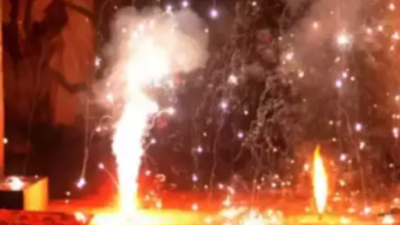- News
- City News
- nagpur News
- Nagpur: With crackers going off indiscriminately, air quality recorded ‘very poor’ early on Tuesday
Nagpur: With crackers going off indiscriminately, air quality recorded ‘very poor’ early on Tuesday

Representative image
NAGPUR: Nagpur’s air quality reached ‘very poor’ level in the early hours of Tuesday after firecrackers were set off across the city from late Monday evening. As per environmentalists, the pollution was worse when compared to last year.
Data released by Central Pollution Control Board (CPCB) revealed that post-midnight, the level of harmful particulate matter (PM) 2.5 reached as high as 391 in the city. This comes under the category of very poor and can lead to respiratory illness or prolonged illness.
Till 5 am, the pollutant level remained above 300 before it started falling after 6 am. The overall air quality index (AQI) of the city was recorded as 200, which is considered moderate. AQI is a tool which measures the ambient concentrations of pollutants and transforms complex data into a single number. Data further showed that the main pollutant in the city was PM2.5.
One of the worst AQI that the city saw during Diwali was 192 recorded in 2017. According to environmentalists, the pollution data is clear evidence of the toxicity caused by burning firecrackers. Analysis done by NGO Green Vigil Foundation showed that two days before Diwali, the city’s air quality was moderate.
On October 23 and 24, the AQI was 101. “The quantity of crackers and pollution levels were both higher this year. It was mostly a result of no time restrictions which were in place last year due to the pandemic,” said Kaustav Chatterjee, founder of the NGO.
Highlighting another crucial factor, the team members stated that citizens were misled under the garb of green crackers. “We surveyed various markets and found that there is no such thing like green crackers. Most of them were fake, with their QR scan codes not working,” said team lead Surbhi Jaiswal.
With this, even those wanting to be environmentally conscious could not do their bit in reducing pollution. “People assumed that since they are buying green crackers, they were not polluting which was far from the reality. Even the genuine crackers developed by the National Environmental Engineering Research Institute (Neeri) only claim to reduce pollution by 30%,” added Chatterjee.
Also, the AQI is only reflective of air pollution in Civil Lines, which is one of the greenest areas in the city. “Despite having four real-tie air quality monitoring station, AQI is calculated only on the basis of Civil Lines’ station. Imagine if air quality there is very poor, what would the level of pollution be in other areas,” said Chatterjee.
Data released by Central Pollution Control Board (CPCB) revealed that post-midnight, the level of harmful particulate matter (PM) 2.5 reached as high as 391 in the city. This comes under the category of very poor and can lead to respiratory illness or prolonged illness.
Till 5 am, the pollutant level remained above 300 before it started falling after 6 am. The overall air quality index (AQI) of the city was recorded as 200, which is considered moderate. AQI is a tool which measures the ambient concentrations of pollutants and transforms complex data into a single number. Data further showed that the main pollutant in the city was PM2.5.
One of the worst AQI that the city saw during Diwali was 192 recorded in 2017. According to environmentalists, the pollution data is clear evidence of the toxicity caused by burning firecrackers. Analysis done by NGO Green Vigil Foundation showed that two days before Diwali, the city’s air quality was moderate.
On October 23 and 24, the AQI was 101. “The quantity of crackers and pollution levels were both higher this year. It was mostly a result of no time restrictions which were in place last year due to the pandemic,” said Kaustav Chatterjee, founder of the NGO.
Highlighting another crucial factor, the team members stated that citizens were misled under the garb of green crackers. “We surveyed various markets and found that there is no such thing like green crackers. Most of them were fake, with their QR scan codes not working,” said team lead Surbhi Jaiswal.
With this, even those wanting to be environmentally conscious could not do their bit in reducing pollution. “People assumed that since they are buying green crackers, they were not polluting which was far from the reality. Even the genuine crackers developed by the National Environmental Engineering Research Institute (Neeri) only claim to reduce pollution by 30%,” added Chatterjee.
Also, the AQI is only reflective of air pollution in Civil Lines, which is one of the greenest areas in the city. “Despite having four real-tie air quality monitoring station, AQI is calculated only on the basis of Civil Lines’ station. Imagine if air quality there is very poor, what would the level of pollution be in other areas,” said Chatterjee.
FOLLOW US ON SOCIAL MEDIA
FacebookTwitterInstagramKOO APPYOUTUBE
Start a Conversation
end of article









